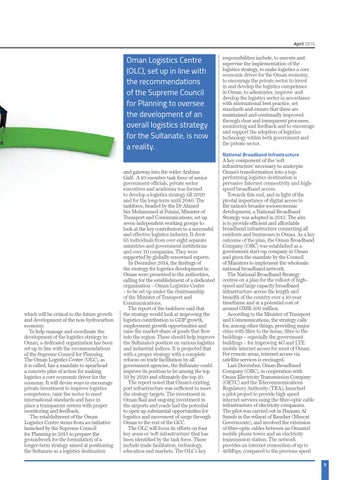April 2015
Oman Logistics Centre (OLC), set up in line with the recommendations of the Supreme Council for Planning to oversee the development of an overall logistics strategy for the Sultanate, is now a reality.
which will be critical to the future growth and development of the non-hydrocarbon economy. To help manage and coordinate the development of the logistics strategy in Oman, a dedicated organization has been set up in line with the recommendations of the Supreme Council for Planning. The Oman Logistics Centre (OLC), as it is called, has a mandate to spearhead a concrete plan of action for making logistics a core economic driver for the economy. It will devise ways to encourage private investment to improve logistics competence, raise the sector to meet international standards and have in place a transparent system with proper monitoring and feedback. The establishment of the Oman Logistics Centre stems from an initiative launched by the Supreme Council for Planning in 2013 to prepare the groundwork for the formulation of a longer-term strategy aimed at positioning the Sultanate as a logistics destination
and gateway into the wider Arabian Gulf. A 10-member task force of senior government officials, private sector executives and academia was formed to develop a logistics strategy till 2020 and for the long-term until 2040. The taskforce, headed by the Dr Ahmed bin Mohammed al Futaisi, Minister of Transport and Communications, set up seven independent working groups to look at the key contributors to a successful and effective logistics industry. It drew 65 individuals from over eight separate ministries and government institutions and over 20 companies. They were supported by globally renowned experts. In December 2014, the findings of the strategy for logistics development in Oman were presented to the authorities, calling for the establishment of a dedicated organisation – Oman Logistics Centre – to be set up under the chairmanship of the Minister of Transport and Communications. The report of the taskforce said that the strategy would look at improving the logistics contribution to GDP growth, employment growth opportunities and raise the market share of goods that flow into the region. These should help improve the Sultanate’s position on various logistics and industrial indices. It is projected that with a proper strategy with a complete refocus on trade facilitation by all government agencies, the Sultanate could improve its position to be among the top 30 by 2020 and ultimately the top 10. The report noted that Oman’s existing port infrastructure was sufficient to meet the strategy targets. The investment in Oman Rail and ongoing investment in the airports and roads had the potential to open up substantial opportunities for logistics and movement of cargo through Oman to the rest of the GCC. The OLC will focus its efforts on four key areas or ‘soft infrastructure’ that has been identified by the task force. These include trade facilitation, technology, education and markets. The OLC’s key
responsibilities include, to execute and supervise the implementation of the logistics strategy, to make logistics a core economic driver for the Oman economy, to encourage the private sector to invest in and develop the logistics competence in Oman, to administer, improve and develop the logistics sector in accordance with international best practice, set standards and ensure that these are maintained and continually improved through clear and transparent processes, monitoring and feedback and to encourage and support the adoption of logistics technology within both government and the private sector. National Broadband Infrastructure A key component of the ‘soft infrastructure’ necessary to underpin Oman’s transformation into a topperforming logistics destination is pervasive Internet connectivity and highspeed broadband access. Towards this end, and in light of the pivotal importance of digital access to the nation’s broader socioeconomic development, a National Broadband Strategy was adopted in 2013. The aim is to provide efficient and affordable broadband infrastructure connecting all residents and businesses in Oman. As a key outcome of the plan, the Oman Broadband Company (OBC) was established as a government start-up company in Oman and given the mandate by the Council of Ministers to implement the wholesale national broadband network. The National Broadband Strategy centres on a plan for the rollout of highspeed and large capacity broadband infrastructure across the length and breadth of the country over a 10-year timeframe and at a potential cost of around OMR 500 million. According to the Minister of Transport and Communications, the strategy calls for, among other things, providing major cities with fibre to the home, fibre to the buildings – especially the government buildings – for improving 4G and LTE mobile internet access for most of Oman. For remote areas, internet access via satellite services is envisaged. Last December, Oman Broadband Company (OBC), in cooperation with Oman Electricity Transmission Company (OETC) and the Telecommunications Regulatory Authority (TRA), launched a pilot project to provide high speed internet services using the fibre-optic cable infrastructure of electricity companies. The pilot was carried out in Hamam Al Sunub in the wilayat of Bausher (Muscat Governorate), and involved the extension of fibre-optic cables between an Omantel mobile phone tower and an electricity transmission station. The network provides an internet connection of up to 40Mbps, compared to the previous speed 5
